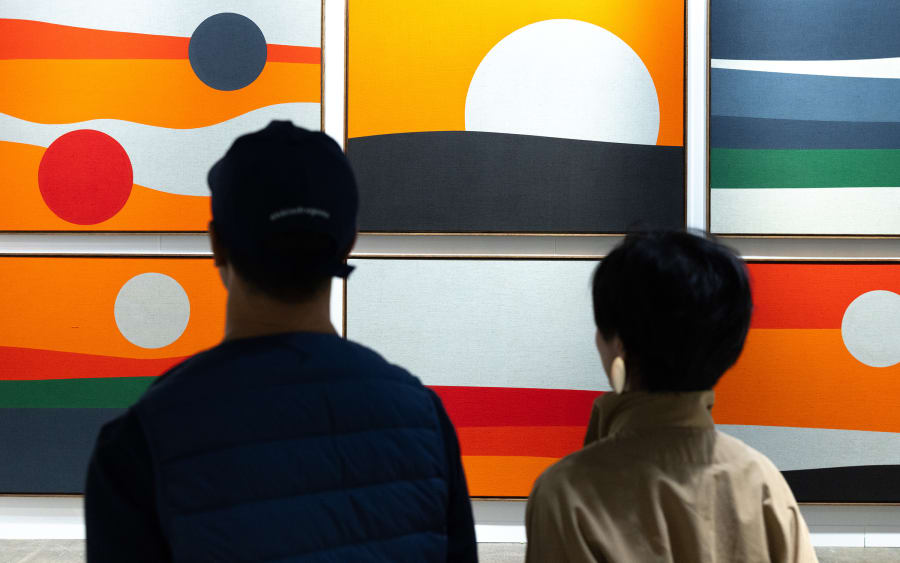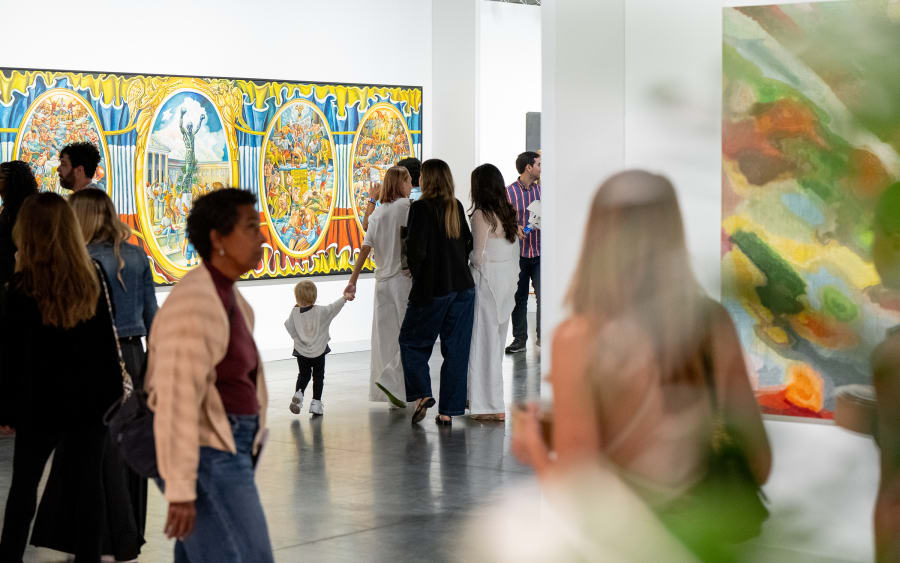The market may be down, but there is no shortage of demand from new buyers. Nearly half (44%) of clients were new to the galleries they bought from in 2024, according to the latest Art Basel and UBS Art Market Report. The share of sales to first-time buyers also increased to 38%, up 5% from 2023. As the data shows, lower price points and easier access via online platforms have contributed to this influx of new buyers – but who are they, what are they buying, and how can galleries convert them into long-term collectors?
It has been widely reported that the lower and mid tiers of the art market are currently outperforming the ultra-premium segment. In 2024, auction sales of works under USD 5,000 grew 7% and dealers with turnovers of less than USD 250,000 reported a 17% increase in sales, according to the Art Market Report. And there is some evidence to suggest that this is partly down to a new wave of buyers entering the market – as the report notes: half of the total transactions for dealers with turnovers of less than USD 250,000 involved collectors buying from them for the first time.
The London-based lawyer and collector Liesl Fichardt suggests a correction in prices for ultra-contemporary artists could also be attracting new buyers with more modest means. ‘Smaller, younger, and even the more established galleries are respecting lower price points for young emerging artists – and some now have separate programs which showcase these artists and make them accessible to a younger collector base,’ she says.
There are newcomers at higher price brackets, too. As the art adviser Nilani Trent puts it: ‘The new wave of collectors has been enticed by new access to wealth and savvy investment knowledge.’ The latest Art Basel and UBS Survey of Global Collecting indicates that more high-net-worth individuals (HNWIs) are buying art for the first time, with 26% of those surveyed having started their collections within the past 5 years – up by 5% on 2023 and notably higher than the 10% recorded in 2022.
New buyers also made up around 30% of the ultra-high-net-worth segment with wealth of over USD 50 million. Though these new collectors still tend to have small collections, the report notes there is ‘some evidence’ of high spending in this segment, and some of the HNWIs entering the market over the past few years ‘have done so at relatively high levels.’
Greater accessibility to the art market via online and social media platforms is undoubtedly helping to entice a new pool of buyers – though many in the art world express an ambivalent view of online viewing rooms, known in the trade as ‘OVRs.’ For dealers and art fairs they provided a much-needed source of income at the height of the pandemic. In March 2020, some 2,000 works were offered through OVRs provided by Art Basel in Hong Kong with an estimated value of USD 270 million.
Even before the pandemic, OVRs had become an accepted way for dealers to sell works ahead of fairs, even for expensive items. In March 2019, just ahead of Art Basel in Hong Kong, Gagosian sold an Albert Oehlen painting for a reported USD 6 million just 3 hours after it was unveiled online, surpassing the artist’s then auction record of USD 4.7 million. Though the buyer was not new to the gallery, they had never acquired a work by Oehlen from Gagosian and bought the painting ‘sight unseen,’ suggesting a level of novelty to the whole process.
Since the pandemic, however, OVRs have somewhat fallen by the wayside. As Kelly Woods, a partner at the New York-based Marianne Boesky Gallery, puts it: ‘The expression OVR feels very 2020 and serious collectors quickly tired of looking at art only online.’ She thinks that ‘real traction’ is increasingly gained by in-person engagements: ‘I would sooner fly to a small town for a day to meet a client (not very green, I know!) than log on to an online sales platform. Online sales are super transactional, and just don’t yield the deep engagement with collectors that we seek. Anyone can make a sale, but you need to build a relationship.’
Furthermore, Woods says, the collector/dealer relationship – particularly for new buyers – has become ‘paramount to filter out all the noise.’ She adds: ‘With so many new galleries, fairs, trends, and artists, collectors want – and like – to work with people they know and trust.’
Nonetheless, there are some segments of the market that feel particularly suited to online platforms – and they are drawing plenty of interest from new collectors. Marketplaces that specialize in prints and multiples, which are less expensive media, are reporting healthy sales. According to The Art Newspaper, sales of print and sculpture editions at the London-based online platform Avant Arte leapt to USD 23 million last year, an increase of 53% on 2023. Around a third of the firm’s client base have reportedly been collecting for less than 2 years.
Fichardt thinks that marketplaces like Avant Arte and Heni, which produces editioned works including Damien Hirst prints and NFTs, have some advantages for collectors. ‘They are easily accessible, sales are instant, the price points are much lower as the works are editions, and it’s not an auction, so you pay the price on the screen,’ she says. But there are also downsides. As Fichardt says: ‘The deal is impersonal and the focus is on buyers, so you can’t sell your work later again via them, as you may be able to do with a gallery or Artsy.’
Auction houses have led the way in successfully migrating their businesses online, as the number of live sales they host has contracted over the past few years. According to the latest Art Market Report, an astonishing 81% of all bids were placed online at Christie’s last year. The auction house’s sales in Asia were driven by an increasing number of new and younger buyers, with 44% of buyers or bidders being millennials or younger. Phillips was also successful in attracting new buyers, with 31% of buyers at auction new to the firm in 2024.
The question is: will galleries follow suit – and do collectors even want them to? Fichardt notes how auction houses ‘are ahead of the game’ when it comes to selling online. She thinks that buying secondary market works at auction online is ‘so much better and efficient,’ but also points out that ‘it’s always best to see the work prior to auction and look at provenance and condition.’
Jeremy Epstein, the cofounder of the London gallery Edel Assanti, says that galleries are ‘keen to develop pipelines for the next generation of collectors, and third-party sales platforms where internet-native audiences can access prices and in-depth information about artists are a logical means of achieving this.’ He thinks that price transparency is ‘clearly a stumbling block for new audiences,’ but notes that, since the pandemic, ‘galleries and artists have been steadily more comfortable with publicly pricing works.’
For Woods, the main problem with online sales platforms lies in their inability to create ‘true human connections.’ As she puts it: ‘We aren’t selling widgets – we are selling art and ideas, we are creating communities, we are having dinners and traveling with clients. For anyone that dedicates their life to art, whether artist, collector, curator, or dealer – nobody got into the art world to sit online and click in a room alone.’
And yet, as Woods acknowledges, online platforms are becoming crucial in reaching new audiences and buyers – and potentially turning them into long-standing collectors. As she says: ‘The reach of online platforms is powerful and invaluable to create those initial connections – how do we then make those more human? More engaging? That’s the question!’
Anny Shaw is a contributing art market editor at The Art Newspaper and author of Resist: Rebellion, Dissent & Protest in Art, Frances Lincoln Publishers Ltd, 2022
Caption for top image: A view of Teresa Gierzynska’s work, presented by Gunia Nowik Gallery at Art Basel Miami Beach 2024.
Published on May 9, 2025.


